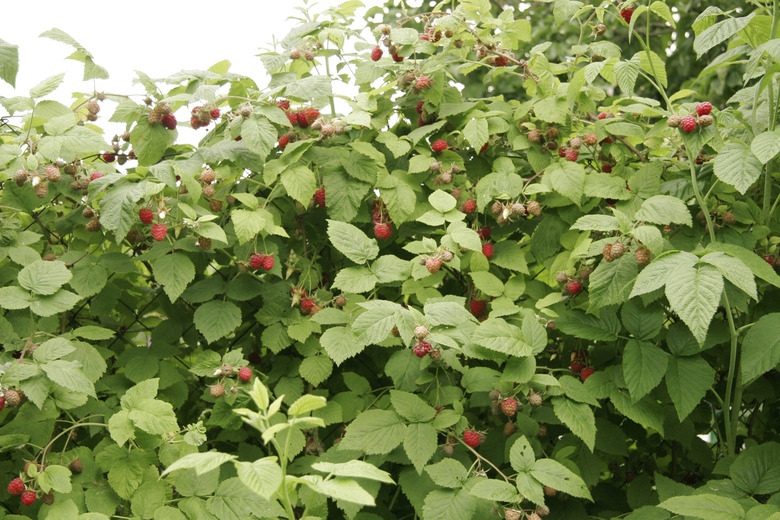How To Kill Raspberry Plants
Wild and cultivated raspberries (Rubus spp.) can become a nuisance in gardens due to their prickly stems and their habit of resprouting from their roots. Wild American red raspberry (Rubus idaeus) and black raspberry (R. occidentalis) grow in USDA zones 3 through 8, and cultivated raspberries grow in U.S. Department of Agriculture plant hardiness zones 4 through 9. Removing raspberry plants involves pruning the canes and digging up the stumps; herbicides also control raspberries.
Stump Removal
Removing raspberry stumps thoroughly can permanently control plants. Raspberries mainly sprout from their stumps, and removing these and covering the remaining roots provides a nonchemical control. Put on thick leather gloves, a long-sleeved shirt and long pants, and prune raspberry canes to 2 to 3 inches tall. Push a sharp spade into the soil 3 to 4 inches around the base of each plant, cutting all its roots. Lever the raspberry plant up and out of the ground. Put the raspberry canes, stumps and roots in the trash, and fill in the hole with fresh soil.
Herbicide Control
Spraying raspberry plants in fall with a systemic herbicide is an effective control. Systemic herbicides move through plants to their roots, and they move most efficiently in fall, when raspberries and other perennial plants are storing energy in their roots before winter. Put on protective clothing, and spray raspberry plants with a 2 percent ready-to-use glyphosate product on a dry, still day before the first frost, covering all the leaves and stems. Glyphosate takes two to three weeks to control raspberry plants. It's harmful to most plants, so take care not to spray plants you wish to keep.
Raspberry in Lawns
Raspberry plants can appear in lawns, but mowing or specialized herbicides control them. Mowing your lawn weekly or more often while raspberry plants are actively growing weakens the plants and provides control over time. Alternatively, spray your lawn with a specialized herbicide that controls raspberries without harming turfgrass. Put on protective clothing and spray a ready-to-use 7.59 percent 2,4-D, 1.83 percent mecoprop-p and 0.84 percent dicamba product at a rate of 4 fluid ounces per 1,000 square feet, or according to the manufacturer's instructions. Apply the product on a still, dry day when temperatures won't exceed 90 degrees Fahrenheit.
Raspberry Invaders
If raspberry plants are invading from a neighbor's garden, a thick plastic sheet provides an effective barrier. Herbicides that control raspberries travel down to the plants' roots, so spraying raspberry plants on your garden border isn't an option because it can damage your neighbor's plants. Dig a narrow trench 1 foot deep at the edge of your garden, and place a sheet of heavy duty plastic plant control material in the trench to that the sheet stands 1 to 2 inches above the soil surface. Fill in the gaps with soil. After controlling the raspberry plants in your garden, check the area every month during the growing season and prune any shoots that are growing over the barrier.
